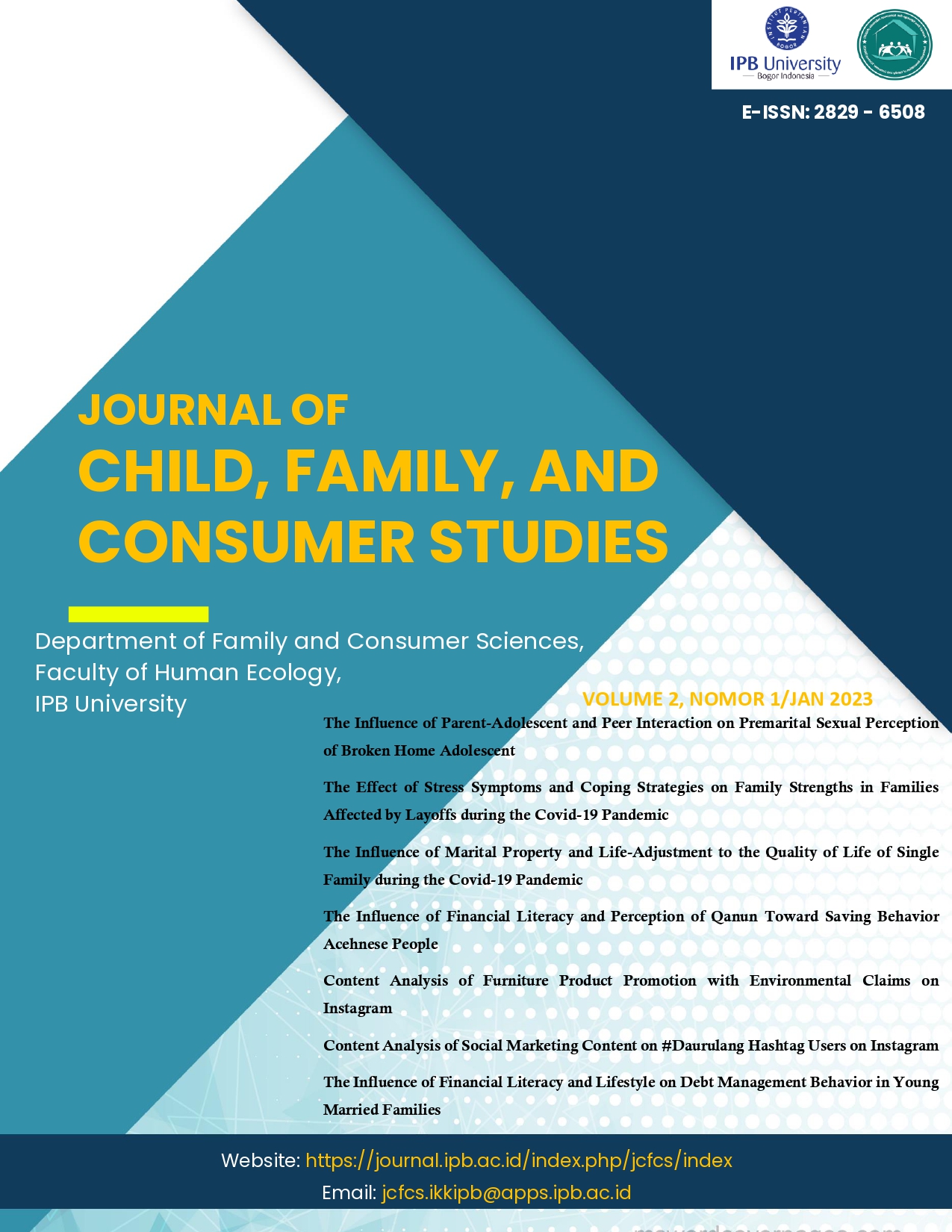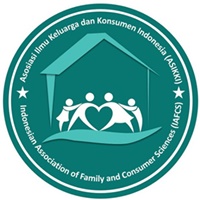CONTENT ANALYSIS OF FURNITURE PRODUCT PROMOTION WITH ENVIRONMENTAL CLAIMS ON INSTAGRAM
Abstract
Increasing public awareness about the environment has pushed companies to apply the green concept and claim their products as environmentally friendly, such as furniture products. This study analyzes product characteristics, promotional posts, and characteristics of claims in furniture product promotion uploads with green claims on Instagram and its fulfillment of the Law of Consumer Protection. The study analyzed 200 promotional uploads of furniture products with green claims on Instagram. The data was processed descriptively using IBM SPSS Statistics 25.0 and Voyant Tools. The results indicate that the uploads contain the most elements of environmentally friendly materials (78%), are subjective (60,5%), product-oriented (85,5%), and are categorized as ambiguous (65%). Furthermore, analysis of the Consumer Protection Law (UUPK) shows that article 9 has the most (59,5%) violated by business actors. Therefore, it requires cooperation between consumers, business actors, and the government to reduce the spread of deceptive green claims on furniture product promotions.
References
Adegbola, O., Gearhart, S., & Skarda-Mitchell, J. (2018). Using Instagram to engage with (potential) consumers: A study of Forbes Most Valuable Brands’ use of Instagram. The journal of social media in society, 7(2), 232-251. https://www.thejsms.org/index.php/JSMS/article/view/436
Asmara, I. W. G., Sujana, I. N., & Puspasutari, N. M. (2019). Perlindungan Hukum terhadap Hak Konsumen atas Informasi Produk Import. Jurnal Analogi Hukum, 1(1), 120-124. https://doi.org/10.22225/ah.1.1.2019.120-124
Bian, X., & Moutinho, L. (2011). Counterfeits and branded products: effects of counterfeit ownership. Journal of Product & Brand Management, 20(5), 379-393. https://doi.org/10.1108/10610421111157900
[BPS] Badan Pusat Statistik. (2021). Statistik E-Commerce 2021. https://www.bps.go.id/publication/2021/12/17/667821e67421afd2c81c574b/statistik-e-commerce-2021.html
Budiarti, F. T. (2017). Konsumsi Furnitur. In Z. Salim, Munadi (Eds), Info Komoditi Furnitur. Kementerian Perdagangan Republik Indonesia (pp. 37-52).
Djunaidi, M., Sholeh, M. A. A., & Mufiid, N. M. (2018). Identifikasi faktor penerapan green supply chain management pada industri furniture kayu. Jurnal Teknik Industri, 19(1), 1-10. https://doi.org/10.22219/JTIUMM.Vol19.No1.1-10
Fan, H., & Zeng, L. (2011). Implementation of green marketing strategy in China: A study of the green food industry. https://www.diva-portal.org/smash/record.jsf?pid=diva2%3A422184&dswid=7535
Fathurrahman, U. F. (2018). Eksplorasi Bambu pada Furnitur Karya Harry Mawardi. Waca Cipta Ruang, 4(2), 312-316. https://www.diva-portal.org/smash/record.jsf?pid=diva2%3A422184&dswid=-7374
Hermita, R. (2016). Pengolahan limbah serbuk kayu menjadi bahan mebel. PROPORSI: Jurnal Desain, Multimedia dan Industri Kreatif, 2(1), 01-12. http://dx.doi.org/10.22303/proporsi.2.1.2016.01-12
Irawan, I. C. (2020). Analisis e-marketing terhadap keputusan pembelian konsumen secara online. Journal of Business and Banking, 9(2), 247-260. https://doi.org/10.14414/jbb.v9i2.1907
Kartikasari, M. D., Dimyati, M., & Sukarno, H. (2018). Pengaruh green marketing dan pengetahuan terhadap keputusan pembelian dengan mediasi minat membeli konsumen Sariayu Martha Tilaar di Kota Jember. E-Journal Ekonomi Bisnis dan Akuntansi, 5(2), 172-177. https://doi.org/10.19184/ejeba.v5i2.8680
Kärnä, J., Juslin, H., Ahonen, V., & Hansen, E. (2001). Green advertising: greenwash or a true reflection of marketing strategies?. Greener Management International, (33), 59-70. https://www.jstor.org/stable/greemanainte.33.59
Khojasteh-Khosro, S., Shalbafan, A., & Thoemen, H. (2022). Consumer behavior assessment regarding lightweight furniture as an environmentally-friendly product. Wood Material Science & Engineering, 17(3), 192-201. https://doi.org/10.1080/17480272.2020.1847187
Krippendorff, K. (2018). Content analysis: An introduction to its methodology. Sage publications.
Maharani, N. Y., & Handojo, O. (2012). Eksplorasi struktur dan kombinasi material produk furnitur rotan. Product Design, 1(1), 161451.
Mahmoud, T. O. (2018). Impact of green marketing mix on purchase intention. International Journal of Advanced and applied sciences, 5(2), 127-135. https://www.researchgate.net/profile/Thoria-Mahmoud/publication/322865212_Impact_of_green_marketing_mix_on_purchase_intention/links/5a817dc6a6fdcc0d4bad5a52/Impact-of-green-marketing-mix-on-purchase-intention.pdf
Nyilasy, G., Gangadharbatla, H., & Paladino, A. (2014). Perceived greenwashing: The interactive effects of green advertising and coIDRorate environmental performance on consumer reactions. Journal of business ethics, 125(4), 693-707. https://doi.org/10.1007/s10551-013-1944-3
Nugrahaningsih, W., & Erlinawati, M. (2017). Implementasi Undang-Undang Nomor 8 Tahun 1999 Tentang Perlindungan Konsumen Terhadap Bisnis Online. Serambi Hukum, 11(01), 27-40.
Parikka, K., & Nissinen, A. (2005). Environmental information in instructions for use of consumer products. Nordic Council of Ministers.
Pujiati, R. (2017). Produksi furnitur Indonesia. In Z. Salim, Munadi (Eds), Info Komoditi Furnitur. Kementerian Perdagangan Republik Indonesia (pp. 7-36).
Puspitarini, D. S., & Nuraeni, R. (2019). Pemanfaatan Media Sosial Sebagai Media Promosi. Jurnal Common, 3(1), 71-80. https://doi.org/10.34010/common.v3i1.195
Rachmawaty, A. (2021). Optimasi Media Sosial Dalam Meningkatkan Penjualan di Masa Pembatasan Sosial Berskala Besar. Tematik: Jurnal Teknologi Informasi Komunikasi (e-Journal), 8(1), 29-44. https://doi.org/10.38204/tematik.v8i1.535
Rani, U., & Pramudyastuti, O. L. (2021). Tipe Pengungkapan Lingkungan dalam Laporan Tahunan Perusahaan Publik di Indonesia. Wahana Riset Akuntansi, 9(1), 34-45. https://doi.org/10.24036/wra.v9i1.111934
Salam, A. S. (2014). Kajian Implementasi Ekolabel Pada Industri Furnitur Kayu di Jepara (Doctoral dissertation, Program Magister Ilmu Lingkungan). http://eprints.undip.ac.id/43062/
Saraswati, M. A., & Sumarwan, U. (2021). Content Analysis of Organic Food Claims on Websites and Instagram Stores. Journal of Consumer Sciences, 6(2), 151-166. https://doi.org/10.29244/jcs.6.2.150-164
Sayuti, N. A., & Zainal Abidin, S. (2012). Sustainable design: The exploration of physical forms of recycled materials in furniture studies. Voice of Academia, 7(2), 25-39. https://localcontent.library.uitm.edu.my/id/eprint/2136/
Smardzewski, J. (2015). Classification and characteristics of furniture. In Furniture Design (pp. 47-95). Springer, Cham. https://doi.org/10.1007/978-3-319-19533-9_2
Suardana, I. W. (2012). Strategi penanggulangan illegal logging melalui ekolabeling. Jurnal Advokasi, 2(1), 12-28.
Suryanadi, P. (2019). Pengaruh iklan hijau pada sikap dan pilihan tema pada iklan hijau. Jurnal Bisnis dan Manajemen, 19(2), 25-38. https://jurnal.uns.ac.id/jbm/article/view/45259
Sumarwan, U. (2014). Perilaku Konsumen. Bogor: IPB Press.
Szabo, S., & Webster, J. (2021). Perceived greenwashing: the effects of green marketing on environmental and product perceptions. Journal of Business Ethics, 171(4), 719-739. https://doi.org/10.1007/s10551-020-04461-0
Tahlia, T., & Saly, J. N. (2021). Perlindungan konsumen atas ketidakjelasan informasi mengenai luas apartemen bogor valley residence berdasarkan undang-undang nomor 8 tahun 1999 tentang perlindungan konsumen (studi kasus: putusan nomor 161/pdt. G/2016/pn. Bgr). Jurnal hukum adigama, 3(2), 246-266.
Tuwaidan, H. F. (2018). Pelanggaran tindak pidana oleh pelaku usaha terhadap kewajiban memberikan informasi yang benar tentang barang dikaitkan dengan perlindungan konsumen. Lex et societatis, 6(8). https://doi.org/10.35796/les.v6i8.23285
Wieser, M. K. (2021). Circular Design Guide for the Use of Plastic in Furniture (Master's thesis, NTNU). https://hdl.handle.net/11250/2829428
Xu, X., Hua, Y., Wang, S., & Xu, G. (2020). Determinants of consumer’s intention to purchase authentic green furnitur. Resources, Conservation and Recycling, 156, 104721. https://doi.org/10.1016/j.resconrec.2020.104721










